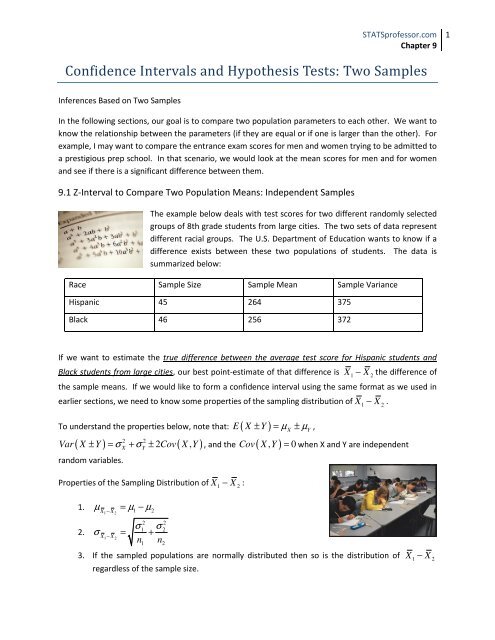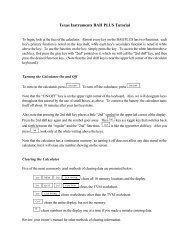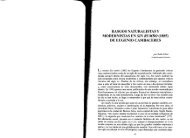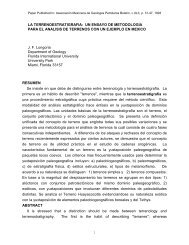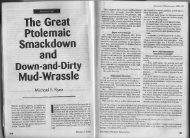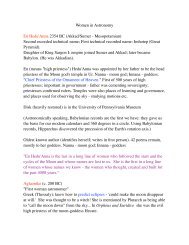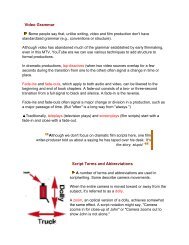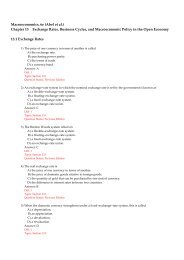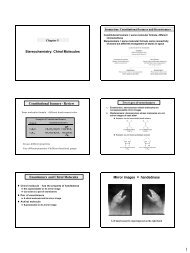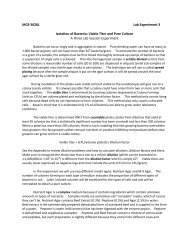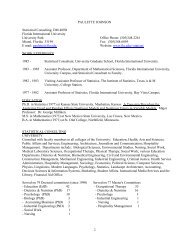Confidence Intervals and Hypothesis Tests: Two Samples - Florida ...
Confidence Intervals and Hypothesis Tests: Two Samples - Florida ...
Confidence Intervals and Hypothesis Tests: Two Samples - Florida ...
You also want an ePaper? Increase the reach of your titles
YUMPU automatically turns print PDFs into web optimized ePapers that Google loves.
STATSprofessor.com<br />
Chapter 9<br />
<strong>Confidence</strong> <strong>Intervals</strong> <strong>and</strong> <strong>Hypothesis</strong> <strong>Tests</strong>: <strong>Two</strong> <strong>Samples</strong><br />
Inferences Based on <strong>Two</strong> <strong>Samples</strong><br />
In the following sections, our goal is to compare two population parameters to each other. We want to<br />
know the relationship between the parameters (if they are equal or if one is larger than the other). For<br />
example, I may want to compare the entrance exam scores for men <strong>and</strong> women trying to be admitted to<br />
a prestigious prep school. In that scenario, we would look at the mean scores for men <strong>and</strong> for women<br />
<strong>and</strong> see if there is a significant difference between them.<br />
9.1 Z-Interval to Compare <strong>Two</strong> Population Means: Independent <strong>Samples</strong><br />
The example below deals with test scores for two different r<strong>and</strong>omly selected<br />
groups of 8th grade students from large cities. The two sets of data represent<br />
different racial groups. The U.S. Department of Education wants to know if a<br />
difference exists between these two populations of students. The data is<br />
summarized below:<br />
Race Sample Size Sample Mean Sample Variance<br />
Hispanic 45 264 375<br />
Black 46 256 372<br />
If we want to estimate the true difference between the average test score for Hispanic students <strong>and</strong><br />
Black students from large cities, our best point-estimate of that difference is X1 − X 2 the difference of<br />
the sample means. If we would like to form a confidence interval using the same format as we used in<br />
earlier sections, we need to know some properties of the sampling distribution of X1 − X 2 .<br />
To underst<strong>and</strong> the properties below, note that: E ( X ± Y ) = µ X ± µ Y ,<br />
2 2<br />
Var ( X ± Y ) = σ + σ ± 2 Cov( X , Y ) , <strong>and</strong> the ( , ) 0<br />
r<strong>and</strong>om variables.<br />
X Y<br />
Properties of the Sampling Distribution of X1 − X 2 :<br />
1.<br />
2.<br />
µ = µ − µ<br />
X1− X2<br />
1 2<br />
σ σ<br />
σ = +<br />
X1− X 2 n n<br />
2 2<br />
1 2<br />
1 2<br />
Cov X Y = when X <strong>and</strong> Y are independent<br />
X − X<br />
3. If the sampled populations are normally distributed then so is the distribution of 1 2<br />
regardless of the sample size.<br />
1
STATSprofessor.com<br />
Chapter 9<br />
4. If the sampled populations are not normal then we will need to have large sample sizes to<br />
X − X by the normal distribution.<br />
ensure that we can approximate the distribution of 1 2<br />
***Note: We are assuming that the samples drawn are independent.<br />
2 2<br />
† † Note: If σ &σ<br />
are unknown, we may use their sample estimates as approximations as long as<br />
1 2<br />
the sample sizes are large (> 30).<br />
Using the properties above <strong>and</strong> the same structure as we used in previous sections, we can find a<br />
formula for the:<br />
(1-α )100% <strong>Confidence</strong> Interval for the True Difference Between the Population Means<br />
(Point Estimator) ± (Number of St<strong>and</strong>ard Deviations)(St<strong>and</strong>ard Error)<br />
X1 − X 2 ± Zα / 2<br />
σ σ<br />
+<br />
n n<br />
2 2<br />
1 2<br />
1 2<br />
* assuming that the two samples are independent.<br />
To use the above formula we must have large sample sizes ( > 30 ), <strong>and</strong> the samples must be r<strong>and</strong>omly<br />
drawn from independent populations.<br />
Remember, that if we do not know the population st<strong>and</strong>ard deviation, but the sample size is large we<br />
can use the sample estimates. In other words,<br />
σ σ<br />
( x1 − x2 ) ± zα / 2 σ ( x1 −x2<br />
) = ( x1 − x2 ) ± zα<br />
/ 2 +<br />
n n<br />
2 2<br />
1 2<br />
1 2<br />
s s<br />
≅ ( x1 − x2 ) ± zα<br />
/ 2 +<br />
n n<br />
2 2<br />
1 2<br />
1 2<br />
Now let’s use the above formula we just found on the example below:<br />
2
STATSprofessor.com<br />
Chapter 9<br />
Example 131: The U.S. Department of Education conducts an assessment of student learning called the<br />
National Assessment of Educational Progress (NAEP). From the 2009, grade<br />
8 mathematics assessment r<strong>and</strong>om samples were drawn from two groups:<br />
Hispanic males from large cities <strong>and</strong> Black males from large cities. The data<br />
is summarized below. Use the data to form a 95% confidence interval for<br />
the true mean difference for grade 8, mathematics scores between Hispanic<br />
males <strong>and</strong> Black males from large cities.<br />
Race Sample Size Sample Mean Sample Variance<br />
Hispanic 45 264 375<br />
Black 46 256 372<br />
Steps for constructing the <strong>Confidence</strong> Interval for the True Difference between the Population Means:<br />
Step 1 Gather Data from Problem, Calculate X1 − X 2 , <strong>and</strong> Calculate<br />
Step 2 Find Zα / 2<br />
Step 3 Use the results from steps 2 <strong>and</strong> 1 to get the margin of error, E = Z<br />
⎡⎣ ( X − X ) − E,( X − X ) + E⎤⎦<br />
Step 4 Form 1 2 1 2<br />
Let’s do that one more time using different data:<br />
2 2<br />
σ1 σ 2 + .<br />
n n<br />
1 2<br />
α / 2<br />
σ σ<br />
+<br />
n n<br />
2 2<br />
1 2<br />
1 2<br />
3
STATSprofessor.com<br />
Chapter 9<br />
Example 132: Recent studies have indicated that low carbohydrate diets are at least as effective as low<br />
fat diets in reducing weight. Does it matter which low carbohydrate diet<br />
is followed? <strong>Two</strong> samples of overweight, premenopausal women were<br />
r<strong>and</strong>omly assigned to either the Atkins diet or the Zone diet for one year.<br />
At no point in the yearlong study was total calorie consumption different<br />
between the two groups. The results of the study are summarized<br />
below. Construct the 98% confidence interval for the true difference<br />
between the weight loss amounts achieved on the two low carbohydrate<br />
diets.<br />
Diet Sample Size Sample Mean Sample St<strong>and</strong>ard Dev.<br />
Atkins 77 10.34 lbs 15.86 lbs<br />
Zone 79 3.52 lbs 11.74 lbs<br />
9.2 Z-Test to Compare <strong>Two</strong> Population Means: Independent <strong>Samples</strong><br />
Next, we will look at the method of testing hypotheses of the form: : ( µ µ )<br />
( µ µ )<br />
1 2 0<br />
H − = D vs.<br />
0 1 2 0<br />
H : − ≠ D (note: as usual the null hypothesis may have the symbols ≤or≥ , <strong>and</strong> the<br />
A<br />
alternative hypothesis may have > or
STATSprofessor.com<br />
Chapter 9<br />
These are basically the same seven steps that we used to test hypotheses in previous sections; however,<br />
there are some minor changes that occur in the steps with asterisks by them. For example, the<br />
hypotheses will look as described above, <strong>and</strong> we will have a new test statistic, given by:<br />
z =<br />
( )<br />
X − X − D<br />
1 2 0<br />
σ σ<br />
+<br />
n n<br />
2 2<br />
1 2<br />
1 2<br />
Other important things to consider are the test assumptions, which are as follows:<br />
1. The samples are r<strong>and</strong>omly selected <strong>and</strong> independent.<br />
2. The sample sizes are both > 30.<br />
Example 133: <strong>Tests</strong> of the effectiveness of Echinacea in preventing upper respiratory infections in<br />
children were conducted in double blind studies. “Days of<br />
Fever” was one criteria used to test the effectiveness of<br />
Echinacea. Among 337 children treated with Echinacea,<br />
the mean number of days with fever was 0.81, with a<br />
st<strong>and</strong>ard deviation of 1.5 days. Among 370 children given a<br />
placebo, the mean number of days of fever was 0.64 with a<br />
st<strong>and</strong>ard deviation of 1.16 days (JAMA Vol. 290). Use a 5%<br />
significance level to test the claim that Echinacea affects the number of days with fever. What is the pvalue<br />
for the test?<br />
Example 134: In a case in Irel<strong>and</strong>, a class action lawsuit was brought<br />
against the government alleging age discrimination. The ages of 31<br />
r<strong>and</strong>omly selected unsuccessful applicants for promotion yielded a<br />
mean age of 47 <strong>and</strong> a st<strong>and</strong>ard deviation of 7.2 years. The ages of 30<br />
r<strong>and</strong>omly selected successful applicants yielded an average age of 43.9<br />
<strong>and</strong> a st<strong>and</strong>ard deviation of 5.9 years. Using a 5% significance level, test<br />
the claim that the government is discriminating based on age.<br />
5
STATSprofessor.com<br />
Chapter 9<br />
9.3 t-Interval to Compare <strong>Two</strong> Population Means: Independent <strong>Samples</strong> (Equal Variances)<br />
What happens when the sample sizes are not greater than 30? There are two consequences of this:<br />
1. We cannot assume approximate normality (solution: We must know the samples are normally<br />
distributed to start with—actually as long as there are no outliers in the data <strong>and</strong> there isn’t too<br />
much of a departure from normality we can still apply this method).<br />
2. The sample st<strong>and</strong>ard deviations may not be reliable estimates of their population counter parts<br />
(solution: We will need to use the t-distribution).<br />
In order to use the t-distribution for this problem, we need to decide between two possible approaches.<br />
The first scenario assumes that the population variances are equal. Assuming the variances are equal<br />
will allow us to use a r<strong>and</strong>om variable that has an exact t-distribution. If we cannot assume this, we may<br />
use some other approach such as the Welch-Satterthwaite method which allows us to approximate the<br />
t-distribution. We will look at the Welch-Satterthwaite method in the next section.<br />
Example 135: The World Anti-Doping Agency funded a study to compare<br />
the effects of Growth Hormone on body composition <strong>and</strong> athletic<br />
performance in women. Among the 16 subjects assigned to the placebo<br />
group, the mean fat mass change after eight weeks was -2.1 pounds with<br />
a st<strong>and</strong>ard deviation of 1.2 pounds. Among the 17 subjects assigned to<br />
injections of growth hormone, the mean fat mass change after eight<br />
weeks -4.4 pounds with a st<strong>and</strong>ard deviation of 1.3 pounds. Construct a 95% confidence interval<br />
estimate of the difference between the mean weight losses for the two diets (assume weight loss is a<br />
normally distributed r<strong>and</strong>om variable <strong>and</strong> assume the two groups have equal variances). Does it seem<br />
that growth hormone has an effect on fat mass in women?<br />
To do the above problem using the t-distribution, we will first assume that the<br />
two variances are equal. It is then reasonable to pool the two sample<br />
2<br />
variances into one sample estimator ofσ<br />
. We call this estimator the pooled<br />
2<br />
sample estimator ofσ<br />
(notice it is just a weighted average with the degrees<br />
of freedom as the weights):<br />
S<br />
2<br />
p<br />
=<br />
( − 1) + ( −1)<br />
n s n s<br />
2 2<br />
1 1 2 2<br />
n + n − 2<br />
1 2<br />
To form our confidence interval we will follow the following set of steps:<br />
6
Step 1 Gather Data for the Problem, Calculate X1 − X 2 , <strong>and</strong> Calculate<br />
Step 2 Find / 2<br />
Step 3 Find E =<br />
tα using n1 + n2<br />
− 2 as the degrees of freedom<br />
S S<br />
2 2<br />
p p<br />
α / 2 +<br />
n1 n2<br />
t<br />
⎡⎣ ( X − X ) − E,( X − X ) + E⎤⎦<br />
Step 4 Form 1 2 1 2<br />
S<br />
2<br />
p<br />
=<br />
STATSprofessor.com<br />
Chapter 9<br />
( − 1) + ( −1)<br />
n s n s<br />
2 2<br />
1 1 2 2<br />
n + n − 2<br />
1 2<br />
9.4 t-Test to Compare <strong>Two</strong> Population Means: Independent <strong>Samples</strong> (Equal Variances)<br />
Small-Sample <strong>Hypothesis</strong> Test of: H : ( µ − µ ) = D , H : ( µ − µ ) ≤ D , or : ( µ µ )<br />
0 1 2 0<br />
0 1 2 0<br />
H − ≥ D<br />
0 1 2 0<br />
We will use the same seven steps as always; however, we will need a new t-test statistic. If we assume<br />
equal variances, the test statistic for these problems will be:<br />
The equal variance case<br />
Steps:<br />
( − ) − ( − 1) + ( −1)<br />
X X D n s n s<br />
t = where S =<br />
1 2<br />
2 2<br />
0 2 1 1 2 2<br />
,<br />
2 2<br />
p<br />
S n1 n2<br />
2<br />
p S<br />
+ −<br />
p<br />
+<br />
n n<br />
1 2<br />
1. Express the original claim symbolically<br />
2. Identify the Null <strong>and</strong> Alternative hypothesis<br />
3. Record the data from the problem<br />
4. Calculate the test statistic*<br />
5. Determine your rejection region<br />
6. Find the initial conclusion<br />
7. Word your final conclusion<br />
, <strong>and</strong> d.f.= n1 + n2<br />
− 2<br />
7
STATSprofessor.com<br />
Chapter 9<br />
Example 136: When investigating the link between birth weights <strong>and</strong> IQ scores, researchers found that<br />
28 subjects with birth weights less than 1000g had a mean IQ of 95.5 <strong>and</strong> a<br />
st<strong>and</strong>ard deviation of 16.0. For 27 subjects with normal birth weights, the<br />
mean IQ was 104.9 with a st<strong>and</strong>ard deviation of 14.5. At the 5% significance<br />
level, test the claim that low birth weight children have lower IQs than<br />
normal birth weight children (assume IQ scores are normally distributed <strong>and</strong><br />
the variances are equal). Is there a possible problem with the assumption of equal variances here?<br />
9.5 t-Interval to Compare <strong>Two</strong> Population Means: Independent <strong>Samples</strong> (Unequal Variances)<br />
Example 137: A study was done to determine the effects of a 6-day administration of growth hormone<br />
on strength gains in men who perform the bench press. <strong>Two</strong><br />
groups of men were r<strong>and</strong>omly selected for the study. Twenty-five<br />
of them were placed into the (placebo) control group. Twentythree<br />
of the men were given a six-day dose of growth hormone (19<br />
mcg/kg/d). On day one of the study strength in the maximum<br />
bench press was recorded for each subject, <strong>and</strong> it was shown that<br />
the two groups were not significantly different from each other at<br />
that point in the study. Seven days after the last of the growth<br />
hormone injections were administered, strength in the maximum<br />
bench press was recorded again. The control group had an average<br />
max bench of 220 pounds <strong>and</strong> a st<strong>and</strong>ard deviation of 24 pounds. The growth hormone group had an<br />
average max bench press of 251 pounds with a st<strong>and</strong>ard deviation of 18 pounds. Construct a 98%<br />
confidence interval estimate of the difference between the mean max bench press for the two groups<br />
(assume maximum bench press is a normally distributed r<strong>and</strong>om variable <strong>and</strong> do not assume equal<br />
variances). Does there appear to be a significant difference between the strength of the two groups?<br />
8
STATSprofessor.com<br />
Chapter 9<br />
To do the above problem without assuming equal variances, we will need to use an approximation<br />
method called the Welch-Satterthwaite method. To do this, let’s modify the traditional four steps:<br />
Step 1 Gather Data from Problem, Calculate X1 − X 2 , Calculate<br />
s s<br />
+<br />
n n<br />
2 2<br />
1 2<br />
1 2<br />
Step 2 Find tα / 2 using the degrees of freedom formula =<br />
2<br />
2<br />
s1<br />
s2<br />
A = , Calculate B = , <strong>and</strong> Calculate<br />
n<br />
n<br />
( ) 2<br />
A + B<br />
1 2<br />
1<br />
*(truncate to the nearest whole<br />
2 2<br />
A B<br />
+<br />
n −1 n −1<br />
number) Note: if the sample sizes are the same you can use n1 + n2<br />
− 2 instead of the formula above.<br />
Step 3 Find E =<br />
s s<br />
2 2<br />
1 2<br />
α / 2 +<br />
n1 n2<br />
t<br />
⎡⎣ ( X − X ) − E,( X − X ) + E⎤⎦<br />
Step 4 Form 1 2 1 2<br />
Note: Do not assume equal variances for the small sample size problems unless specified. That means<br />
you will use the Welch-Satterthwaite method unless the problem says you can assume equal variances.<br />
Example 137.5 Student loan debt is a concern for many college bound high school seniors. In Miami, the<br />
two top research schools are <strong>Florida</strong> International University <strong>and</strong> the<br />
University of Miami. A sample of 29 recent graduates from FIU who<br />
borrowed money for school had an average debt load of $16,026 <strong>and</strong><br />
a st<strong>and</strong>ard deviation of $10,738. A sample of 29 recent graduates<br />
from UM who borrowed money for school had an average debt load<br />
of $26,438 <strong>and</strong> a st<strong>and</strong>ard deviation of $16,203. Use the data from<br />
the two r<strong>and</strong>omly selected groups of college graduates to construct a<br />
99% confidence interval estimate of the true difference between the<br />
average amount of student loan debt carried by FIU graduates <strong>and</strong><br />
UM graduates.<br />
2<br />
9
STATSprofessor.com<br />
Chapter 9<br />
9.6 t-Test to Compare <strong>Two</strong> Population Means: Independent <strong>Samples</strong> (Unequal Variances)<br />
Small-Sample <strong>Hypothesis</strong> Test of H : ( µ − µ ) = D , H : ( µ − µ ) ≤ D , or : ( µ µ )<br />
0 1 2 0<br />
0 1 2 0<br />
H − ≥ D<br />
0 1 2 0<br />
We will use the same seven steps as always; however, we will need a new t-test statistic. If we assume<br />
unequal variances, the test statistic for these problems will be:<br />
The Welch-Satterthwaite method (unequal variance case):<br />
t =<br />
( )<br />
X − X − D<br />
1 2 0<br />
s s<br />
+<br />
n n<br />
2 2<br />
1 2<br />
1 2<br />
( ) 2<br />
A + B<br />
2<br />
s1<br />
s<br />
, where t has degrees of freedom =<br />
<strong>and</strong> A = <strong>and</strong> B =<br />
2 2<br />
A B n1<br />
n<br />
+<br />
n −1 n −1<br />
1 2<br />
Note: if the sample sizes are the same you can use n1 + n2<br />
− 2 instead of the formula above.<br />
Example 138: When investigating the link between consuming canned foods <strong>and</strong> bisphenol A (BPA)<br />
levels in people, researchers found that 26 subjects who ate a can of soup<br />
everyday for five days had average BPA levels of 20.8 micrograms per liter<br />
of urine <strong>and</strong> a st<strong>and</strong>ard deviation of 3.1 micrograms per liter. For 27<br />
subjects who ate fresh soup, their mean levels were 1.1 micrograms per<br />
liter of urine <strong>and</strong> a st<strong>and</strong>ard deviation of 0.5 micrograms per liter. At the<br />
5% significance level, test the claim that consuming canned soup raises<br />
the concentration of BPA in urine (assume BPA levels are normally distributed <strong>and</strong> do not assume equal<br />
variances).<br />
2<br />
2<br />
2<br />
10
Summary flow chart for methods:<br />
STATSprofessor.com<br />
Chapter 9<br />
9.7 <strong>Hypothesis</strong> Test to Compare <strong>Two</strong> Population Means: Matched-Pair Experiments<br />
Comparing <strong>Two</strong> Populations Means: Paired Difference Experiments<br />
Comparing <strong>Two</strong> Population Means: Matched Pairs<br />
For large samples where we<br />
2 2<br />
do not knowσ or σ , we<br />
1 2<br />
2 2<br />
can use s or s as<br />
substitutes.<br />
1 2<br />
Recall that our goal in the previous section was to be able to detect a difference between two<br />
population averages. The example problem below requires a similar sort of analysis. We would like to<br />
11
STATSprofessor.com<br />
Chapter 9<br />
be able to detect if the scores for students taking the FCAT math section improve after completing a<br />
series of FCAT prep classes.<br />
Example 139: Below is a table of FCAT SSS developmental scores for a group of students who were<br />
struggling with math in the 3 rd grade.<br />
FCAT math scores for 8 struggling students<br />
Student After Prep Before Prep<br />
1 290 275<br />
2 275 270<br />
3 380 370<br />
4 260 245<br />
5 340 325<br />
6 270 260<br />
7 280 270<br />
8 215 200<br />
We want to test the claim: The prep classes work to improve FCAT math SSS scores.<br />
(In symbolic form: µ − µ > 0 )<br />
After Before<br />
Using the method from the previous section where we assume the two sets of data are drawn from<br />
independent populations, we get a test statistic of: t = 0.467, which is not significant. This means we<br />
cannot reject the null ( µ − µ ≤ 0 ), <strong>and</strong> we conclude that the prep classes are not effective at<br />
After Before<br />
raising FCAT SSS scores. Does that seem correct when we look at the table of values above? Isn’t it true<br />
that every student improved their math score after attending the prep classes? Then why did we get<br />
this result?<br />
The answer is that the method we used is not valid here. In the previous section, our assumption was<br />
that the two samples were independent, but that is not true here. The two samples above were drawn<br />
from the same students. We gave them the FCAT, <strong>and</strong> then we gave them prep classes <strong>and</strong> retested the<br />
same students.<br />
12
STATSprofessor.com<br />
Chapter 9<br />
Okay, so we violated the assumptions—so what? Why does that affect our ability to detect the<br />
difference between the two FCAT<br />
performances? The answer lies in the<br />
quantity:<br />
S<br />
2<br />
p<br />
=<br />
( − 1) + ( −1)<br />
n s n s<br />
2 2<br />
1 1 2 2<br />
n + n − 2<br />
1 2<br />
= 2,581.03 This is<br />
our pooled variance for the t-test we<br />
constructed above. What is this measuring in<br />
this case? It is measuring the variation of the<br />
FCAT scores between the students—not the<br />
differences between the scores each<br />
individual earned before <strong>and</strong> after prep. In<br />
other words, it is not looking at the difference<br />
between before <strong>and</strong> after exams, but rather<br />
looking at the differences between student<br />
abilities. We know there are great differences<br />
between different students’ ability, but that is<br />
not what we want to look at in this problem.<br />
How does using the wrong measure of<br />
variation affect our hypothesis test?<br />
We are trying to look at the average difference between the before <strong>and</strong> after FCAT scores. If the test<br />
prep has no effect, we would expect the average difference of before <strong>and</strong> after scores to be zero. To<br />
know if the true difference is significantly different from zero, we will need to consider the variation of<br />
the differences between before <strong>and</strong> after FCAT scores. If the average distance between the before <strong>and</strong><br />
after FCAT scores <strong>and</strong> zero is not much larger than (or is small) compared to the natural variation that<br />
occurs between retakes of the FCAT, we will conclude there is no significant improvement due to the<br />
prep classes.<br />
To help you underst<strong>and</strong> this idea, consider this simple example: Johnny scores a 170 on his FCAT math<br />
section, <strong>and</strong> Suzy scores a 460 on her FCAT math section. After taking the prep classes, Johnny retakes<br />
the FCAT <strong>and</strong> improves his grade to a 190, while Suzy’s score jumps to a 490.<br />
What is the difference within each student’s before <strong>and</strong> after scores?<br />
Suzy’s score change = 490 – 460 = +30, Johnny’s score change = 190 – 170 = +20<br />
Average score change = + 25<br />
13
What is the difference between the students’ scores<br />
however?<br />
Before difference = Suzy(460) – Johnny(170) = 290<br />
After difference = Suzy(490) – Johnny(190) = 300<br />
Average difference = 295<br />
STATSprofessor.com<br />
Chapter 9<br />
If you compare these two numbers, it is clear the average within score change is quite small compared<br />
to the differences between Johnny’s <strong>and</strong> Suzy’s FCAT scores, but we do not want to compare these two<br />
quantities do we? No, we would want to compare the average before <strong>and</strong> after score change against<br />
the variation of the individual students’ score changes not the variation of the individual test scores<br />
(that variation is great do to the different math ability of the students).<br />
We need to find a way to ignore these differences between different students’ FCAT scores. These<br />
differences are not important to us. In other words, we know Suzy scores higher than Johnny already.<br />
We want to know if the prep course helps students do better regardless of how they did before. We do<br />
not want the differences in student ability to obscure the differences between before <strong>and</strong> after scores<br />
that we are interested in. If we can’t block out the differences between students, we will never be able<br />
to detect the smaller differences that are occurring between before <strong>and</strong> after test scores. It would be<br />
like trying to hear the footsteps of a mouse running across a concert hall floor while a rock concert is<br />
being played in the same hall.<br />
Blocking<br />
We do have a very simple solution to this problem: we will run a one-sample t-test on the differences<br />
between before <strong>and</strong> after scores:<br />
Subject 1 2 3 4 5 6 7 8<br />
After 290 275 380 260 340 270 280 215<br />
Before 275 270 370 245 325 260 270 200<br />
Just subtract each subject’s after <strong>and</strong> before scores…<br />
14
Subject 1 2 3 4 5 6 7 8<br />
After 290 275 380 260 340 270 280 215<br />
Before 275 270 370 245 325 260 270 200<br />
Difference 15 5 10 15 15 10 10 15<br />
STATSprofessor.com<br />
Chapter 9<br />
Then treat the row of differences as a single sample. We can get the average difference X d = 11.875 ,<br />
the st<strong>and</strong>ard deviation for the differences S d = 3.720 , <strong>and</strong> the number of differences n d = 8 . Then we<br />
can use the same test statistic we used for a one-sample t-test:<br />
t<br />
X<br />
− µ<br />
d d = with degrees of freedom = nd − 1<br />
Sd<br />
n<br />
d<br />
Where do we get µ d ? That is the hypothesized value for the true average difference. This leads us to<br />
the question, “what will our claims look like?”<br />
We will be conducting our hypothesis test using the following pair of competing claims:<br />
H : µ ≤ D<br />
0 d 0<br />
H : µ > D *<br />
A d<br />
0<br />
Now let’s finish our example properly:<br />
*Of course, all the usual null/alternative pairings are possible<br />
1. Express the original claim symbolically: µ d > 0 *<br />
H0<br />
: µ d ≤ 0<br />
2. Identify the Null <strong>and</strong> Alternative hypothesis:<br />
H : µ > 0<br />
A d<br />
3. Record the data from the problem: X = 11.875, S = 3.720, n = 8, α = 0.05<br />
d d d<br />
X d − µ d 11.875<br />
4. Calculate the test statistic: t = = ≈ 9.029<br />
S 3.720<br />
d<br />
n<br />
d<br />
5. Determine your rejection region: t > 1.895<br />
6. Find the initial conclusion: Reject the null, support the alternative<br />
7. Word your final conclusion: The sample data support the claim that the prep classes are<br />
effective at improving student’s FCAT SSS math scores.<br />
8<br />
15
STATSprofessor.com<br />
Chapter 9<br />
*Note: our claim that the prep classes improve scores indicates that theoretically the ‘after’ exam will be<br />
better than the ‘before’ exam. This means if we form the difference d = After – Before, the differences<br />
<strong>and</strong> their average should be positive, i.e. µ d > 0.<br />
Some other examples where blocking would be necessary:<br />
• A study of the effect of a Gulf hurricane on gas prices. If we poll stations across the country<br />
<strong>and</strong> look at the price of gas before <strong>and</strong> after the storm at those stations. Since prices vary from<br />
state to state, region to region, we would want to block out those differences by looking at<br />
every station twice (once before the storm <strong>and</strong> once after).<br />
• A study wants to look at the difference between starting salaries of their male <strong>and</strong> female<br />
graduates. Since differences between majors <strong>and</strong> GPAs could affect salaries we would pair<br />
male <strong>and</strong> females in the study who have similar GPAs <strong>and</strong> majors. Then we would look at the<br />
differences in their starting offers.<br />
• A study wants to compare the absorption rates of two different drugs for pain relief. Since<br />
there are so many possible differences between patients it would be best to make sure every<br />
study participant takes both drugs one after the other (allowing for the total elimination of the<br />
drug that was administered first). This will ensure the differences between the patients do not<br />
obscure the differences in the absorption rates between the drugs.<br />
Example 140 The drug Depo-Provera is often used for patients who exhibit hypersexual behavior caused<br />
by traumatic brain injury (TBI). The results of a study conducted on 8<br />
patients who exhibited such behavior are included below. Each patient<br />
had their testosterone levels taken before treatment with Depo <strong>and</strong><br />
after treatment. At the 1% significance level, test the claim that the<br />
drug is effective at reducing testosterone levels in TBI patients.<br />
Patient 1 2 3 4 5 6 7 8<br />
Pretreatment 849 903 890 1092 362 900 1006 672<br />
After Depo 96 41 31 124 46 53 113 174<br />
Differences 753 862 859 968 316 847 893 498<br />
Next, we will look at the confidence interval for paired differences data.<br />
16
STATSprofessor.com<br />
Chapter 9<br />
9.8 <strong>Confidence</strong> Interval to Compare <strong>Two</strong> Population Means: Matched-Pair Experiments<br />
The procedure to construct a confidence interval for data from a Matched-Pair Experiment involves the<br />
same approach that we used in our earlier work with the hypothesis test. We will first need to find all of<br />
the before – after differences.<br />
<strong>Confidence</strong> Interval for Paired Differences:<br />
Required assumptions:<br />
⎡ Sd S ⎤<br />
d<br />
⎢X d − tα / 2 , X d + tα<br />
/ 2 ⎥<br />
⎢⎣ nd nd<br />
⎥⎦<br />
1. We must assume that the sample was chosen r<strong>and</strong>omly from the target population.<br />
2. We must assume that the population of differences has a normal distribution.<br />
Steps to Form a <strong>Confidence</strong> Interval for Matched-Pairs Data:<br />
Step 1 Use subtraction to create your set of differences <strong>and</strong> determine , ,<br />
d d d<br />
level.<br />
Step 2 Find tα /2<br />
Step 3 Use the results from steps 2 <strong>and</strong> 1 to get the margin of error, E = tα<br />
/2<br />
Step 4 Form ( X − E, X + E)<br />
d d<br />
n X S , <strong>and</strong> your confidence<br />
Example 141 Use the data from the Depo-Provera study to form a 98%<br />
confidence interval for µ d , then interpret the results. Are they consistent<br />
with the results found in the hypothesis test we conducted?<br />
s<br />
d<br />
n<br />
d<br />
17
Example 142 Use the data from the FCAT problem that opened this section to form a 90% confidence<br />
interval for µ d the true average differe difference between before <strong>and</strong> after FCAT scores <strong>and</strong> interpret inter the<br />
results.<br />
STATSprofessor.com<br />
Chapter 9<br />
9.9 Inference Procedures to Compare <strong>Two</strong> Population Proportions: Independent Sampling<br />
Many times we have a need to answer questions that involve the comparison of two population<br />
proportions. Consider the example below:<br />
Example 143: A product reliability study was conducted on laptops by the company Square Trade Inc.<br />
Among 11,500 entry-level level laptops (priced between $400 - $1000) followed for one year, 541<br />
malfunctioned. Among 9,300 premium laptops (priced over $1000) followed for one year, 391<br />
malfunctioned. Use a 0.01 significance level to test the claim that the incidence of mal malfunction mal is higher<br />
for entry-level laptops than it is for premium laptops. Does es it seem that spending more money on a<br />
laptop will offer you some protection otection from the inconvenience of a malfunction?<br />
18
STATSprofessor.com<br />
Chapter 9<br />
To answer this question we need to know what quantities to compare. Let’s look at what we have here:<br />
Entry-level Premium<br />
X 541 391<br />
n 11,500 9,300<br />
ˆp 0.047 0.042<br />
Clearly, for this sample, premium laptops had a slightly lower malfunction rate for the first year, but is<br />
this difference just a coincidence? Maybe this could have happened by chance—after all the there is<br />
always some r<strong>and</strong>om sampling error present.<br />
What we can do is create a test statistic around the difference between these two sample proportions<br />
( pˆ pˆ<br />
)<br />
− using the st<strong>and</strong>ard deviation of the sampling distribution for the difference between these<br />
1 2<br />
two sample proportions. Then if the sample sizes are large enough*, we can express the probability that<br />
we would observe this difference ( pˆ pˆ<br />
)<br />
assumption under the null hypothesis).<br />
− by r<strong>and</strong>om chance given that they are really the same (the<br />
1 2<br />
*Sample sizes are large enough when ˆ 3<br />
ˆ ˆ pq<br />
p ± is entirely captured inside [0, 1]. Another rule of<br />
n<br />
thumb that is used is: <strong>Samples</strong> sizes are large enough if n1 pˆ ˆ<br />
1 ≥ 15 <strong>and</strong> n1q1 ≥15<br />
n pˆ ≥15 <strong>and</strong> n qˆ<br />
≥15<br />
So our point estimator for the true population difference will be: ( pˆ − pˆ<br />
)<br />
The st<strong>and</strong>ard error of its sampling distribution will be:<br />
p q p q ⎛ 1 1 ⎞ x + x<br />
+ ≈ pq ˆ ˆ ⎜ + ⎟,<br />
where pˆ<br />
=<br />
n n ⎝ n n ⎠ n + n<br />
1 1 2 2 1 2<br />
1 2 1 2 1 2<br />
2 2 2 2<br />
1 2<br />
19
STATSprofessor.com<br />
Chapter 9<br />
Note: ˆp is considered the pooled estimator of the population proportion under the null’s assumption that<br />
the two groups have the same proportion.<br />
Our competing hypotheses will be: H : ( p − p ) ≤ 0 Vs. H ( p p )<br />
also)<br />
Our test statistic will be:<br />
0 1 2<br />
( pˆ ˆ<br />
entry−level − p premium ) x1 + x2<br />
z ≈ , where pˆ<br />
=<br />
⎛ 1 1 ⎞<br />
n + n<br />
pq ˆ ˆ ⎜ + ⎟<br />
n n<br />
⎝ 1 2 ⎠<br />
A<br />
: − > 0 ( = , ≠, ≥ , < are possible<br />
1 2<br />
1 2<br />
Now let us determine if we can support the claim that entry-level laptops malfunction more than<br />
premium laptops.<br />
1. Express the original claim symbolically: pentry− level > p premium<br />
2. Identify the Null <strong>and</strong> Alternative hypothesis:<br />
0<br />
( entry−level premium )<br />
( −<br />
)<br />
H : p − p ≤ 0<br />
H : p − p > 0<br />
A entry level premium<br />
3. Record the data from the problem: pentry− level = 0.047, p premium<br />
4. Calculate the test statistic:<br />
= 0.042, α = 0.01<br />
( pˆ ˆ entry−level − p premium )<br />
z ≈ =<br />
⎛ 1 1 ⎞<br />
pq ˆ ˆ ⎜ + ⎟<br />
⎝ n1 n2<br />
⎠<br />
0.005<br />
≈ 1.73<br />
⎛ 1 1 ⎞<br />
0.0448(0.9552) ⎜ + ⎟<br />
⎝11500 9300 ⎠<br />
5. Determine your rejection region: Z > 2.326<br />
6. Find the initial conclusion: Do not reject the null, Do not support the alternative<br />
7. Word your final conclusion: The sample data does not support the claim that entry-level laptops<br />
have a greater malfunction rate in the first year of owner ship than premium laptops.<br />
20
STATSprofessor.com<br />
Chapter 9<br />
Example 144 In 1995, the American Cancer Society r<strong>and</strong>omly sampled 1500 adults of which 555 smoked.<br />
In 2005, they surveyed 1750 adults <strong>and</strong> found that 578 of them smoked. At the 5% level of significance<br />
test the claim that the proportion of smokers in the population decreased over the ten year period.<br />
What is the p-value for the test?<br />
Let’s now look at the confidence interval for the difference between two proportions:<br />
<strong>Confidence</strong> Interval for( p − p ) :<br />
1 2<br />
p q p q pˆ qˆ pˆ qˆ<br />
p − p ± z + ≈ p − p ± z +<br />
( ˆ ˆ ) ( ˆ ˆ )<br />
1 1 2 2 1 1 2 2<br />
1 2 α / 2<br />
n1 n2 1 2 α / 2<br />
n1 n2<br />
Steps for constructing the <strong>Confidence</strong> Interval for the True Difference between the Population<br />
Proportions (large, independent samples):<br />
Step 1 Gather Data from Problem, 1 1 1 2 2 2<br />
Step 2 Find Zα / 2<br />
n , pˆ , qˆ , n , pˆ , qˆ , <strong>and</strong> the <strong>Confidence</strong> level.<br />
Step 3 Use the results from steps 2 <strong>and</strong> 1 to get the margin of error, E =<br />
Step 4 Form ( ˆ ˆ ) , ( ˆ ˆ )<br />
⎡ p − p − E p − p + E⎤<br />
⎣ 1 2 1 2 ⎦<br />
z<br />
pˆ qˆ pˆ qˆ<br />
1 1 2 2<br />
α /2 +<br />
n1 n2<br />
21
Example 145 R<strong>and</strong>y Stinchfield of the University of Minnesota studied<br />
the gambling activities of public school students in 1992 <strong>and</strong> 1998<br />
(Journal of Gambling Studies, Winter 2001). His results are reported<br />
below. Form a 99% confidence interval to estimate the true difference<br />
between the proportion of public school students who gambled in<br />
1992 <strong>and</strong> 1998. Does there seem to be a difference?<br />
1992 1998<br />
Survey n 21,484 23,199<br />
Number who gambled 4,684 5,313<br />
Proportion who gambled .218 .229<br />
STATSprofessor.com<br />
Chapter 9<br />
Example 146 In 1995, the American Cancer Society r<strong>and</strong>omly sampled 1500 adults of which 555 smoked.<br />
In 2005, they surveyed 1750 adults <strong>and</strong> found that 578 of them<br />
smoked. Form a 90% confidence interval for the difference between<br />
the proportion of smokers in 1995 <strong>and</strong> 2005. Has the proportion<br />
decreased over the ten year period?<br />
Interpreting confidence intervals involving the difference between two population proportions is as easy<br />
as it was for the differences between two means. If the interval is entirely positive, the first proportion<br />
in your difference is larger. If the interval is entirely negative, the second proportion in your difference<br />
is larger, <strong>and</strong> finally, if the interval contains zero it means we cannot say there is a significant difference<br />
between the two proportions.<br />
Consider the set of confidence intervals provided below from the Framingham Heart Study which looked<br />
at the effects of one's social network on drinking habits:<br />
22
STATSprofessor.com<br />
Chapter 9<br />
23
9.10 Using the f-table to Find Critical Values<br />
STATSprofessor.com<br />
Chapter 9<br />
Before we begin the next topic, let’s learn how to use the F table found in the back of most textbooks to<br />
find critical values. If you are curious about where the F-distribution comes from it is the ratio of two<br />
chi-square distributions with degrees of freedom ν1 <strong>and</strong>ν 2 , respectively, where each chi-square has first<br />
been divided by its degrees of freedom.<br />
We will be working with two independent samples of data in the next section, <strong>and</strong> we will have a need<br />
to use the F-distribution. The F-tables, like the Z-table <strong>and</strong> t-table, are used to find critical values. When<br />
we use the F tables, there will be two degrees of freedom. The degrees of freedom will be 1 1 n − <strong>and</strong><br />
1 n − for the two sample sizes in the problem. The F-test stat is a fraction, so we will consider one of<br />
2<br />
these degrees of freedom to be the numerator degrees of freedom <strong>and</strong> one to be the denominator<br />
degrees of freedom. This will depend how we set up the ratio in the given problem. For now let’s just<br />
assume 1 1 n − is the numerator degree of freedom <strong>and</strong> 2 1 n − is the denominator’s degree of freedom.<br />
We will also need an alpha value in each problem. This α value will be the amount of area that will be<br />
found in the upper tail of our F-distribution beyond our critical value.<br />
f α<br />
Example 147 Find the critical value 1 2<br />
Example 148 Find the critical value 1 2<br />
n −1, n − 1, = 30,40,0.01<br />
f α<br />
n −1, n − 1, = 6,24,0.025<br />
f<br />
f<br />
24
STATSprofessor.com<br />
Chapter 9<br />
9.11 <strong>Hypothesis</strong> Test to Compare <strong>Two</strong> Population Variances: Independent Sampling<br />
Comparing <strong>Two</strong> Population Variances: Independent Sampling<br />
There are a lot of situations where we want to know if the populations have the same variances. In fact,<br />
we just studied hypothesis testing methods for comparing two means from independent populations. In<br />
that section when the sample sizes were small we needed to assume either that the population<br />
variances were equal or that they weren’t, but with the test we learn here today, we won’t have to<br />
assume. At other times, we will actually want to compare the variances of two groups for its own sake<br />
instead of just performing the test to know if we can go forward with a test of the means. The following<br />
is an example of the latter type of problem:<br />
Example 149: Disney is comparing two methods of receiving customers at its City Halls in the Magic<br />
Kingdom <strong>and</strong> Disney L<strong>and</strong>. They are deciding if using one long line<br />
(used in Disney L<strong>and</strong>) is better than allowing people to line up in<br />
separate lines for each teller (used in Magic Kingdom). They<br />
collected waiting time data (measured in minutes) for both<br />
locations:<br />
Disney L<strong>and</strong>: n = 41, X = 5.15, S = 0.48<br />
Magic Kingdom: n = 61, X = 5.15, S = 1.23<br />
Test the claim at the 5% significance level that Disney L<strong>and</strong> “City Hall” lines have a smaller variance than<br />
the lines at “City Hall” in Magic Kingdom.<br />
To compare variances we will use an F-test. The F-distribution is the ratio of two chi-square<br />
distributions with degrees of freedom ν1 <strong>and</strong>ν 2 , respectively, where each chi-square has first been<br />
divided by its degrees of freedom. It turns out that if a r<strong>and</strong>om variable is normally distributed <strong>and</strong> has<br />
population variance<br />
2<br />
σ the quantity<br />
( − )<br />
2<br />
S n<br />
2<br />
σ<br />
1<br />
~ χn<br />
2<br />
−1<br />
(is chi-squared with degree of freedom n-1). This<br />
means that if we divide our two sample variances we will get a r<strong>and</strong>om variable that has an Fdistribution:<br />
25
S<br />
S<br />
2<br />
1<br />
2<br />
2<br />
~ F<br />
STATSprofessor.com<br />
Chapter 9<br />
Note, actually we are forming the ratio of two chi-squared r<strong>and</strong>om variables divided by their degrees of<br />
feedom:<br />
( −1<br />
)<br />
/ ( n −1)<br />
S n S<br />
2 2<br />
1 1 1<br />
2 1<br />
2<br />
σ = σ<br />
2 2<br />
2 ( 2 −1<br />
) 2<br />
/ ( n<br />
2<br />
2 −1)<br />
2<br />
=<br />
2<br />
S1<br />
2<br />
2<br />
S n S S<br />
σ<br />
σ<br />
~ F<br />
(Why doesn’t<br />
Answer: Our null hypothesis will include the assumption that σ = σ ).<br />
To conduct our test we will use the ratio of our two sample variances:<br />
2<br />
1<br />
σ & 2<br />
σ stay in the denominators?<br />
2<br />
1<br />
2<br />
2<br />
S<br />
S<br />
2<br />
2<br />
1 ~ F 2 n1 −1, n2<br />
− 1<br />
2<br />
*<br />
*Because of the way most F-tables are constructed, we will always put the larger sample variance on<br />
top. One way to do this is to always label the sample with the larger sample variance as representing<br />
population 1.<br />
2<br />
1<br />
0 2<br />
σ 2<br />
Our competing hypotheses will be: H : 1<br />
σ<br />
≤ Vs. H A : 1<br />
σ<br />
> (= vs. ≠ are also possible).<br />
σ<br />
Now let’s work our example:<br />
1. Express the original claim symbolically:<br />
variance was the smaller of the two)<br />
2. Identify the Null <strong>and</strong> Alternative hypothesis:<br />
σ<br />
2<br />
1<br />
2<br />
2<br />
2<br />
MagicKingdom<br />
2<br />
DisneyL<strong>and</strong><br />
σ<br />
H<br />
H<br />
2<br />
MagicKingdom<br />
0 2<br />
σ DisneyL<strong>and</strong><br />
A<br />
> 1 (because we claimed Disney L<strong>and</strong>’s<br />
σ<br />
: ≤ 1<br />
σ<br />
: > 1<br />
σ<br />
2<br />
MagicKingdom<br />
2<br />
DisneyL<strong>and</strong><br />
Disney L<strong>and</strong>: n = 41, X = 5.15, S = 0.48<br />
3. Record the data from the problem:<br />
Magic Kingdom: n = 61, X = 5.15, S = 1.23<br />
4. Calculate the test statistic:<br />
( 1.23)<br />
( )<br />
2<br />
2<br />
0.48 =<br />
6.566<br />
5. Determine your critical value <strong>and</strong> rejection region: F > 1.64 (see the F-Tables)<br />
26
Steps to determine the critical value for an F-test:<br />
a. Determine the number of tails <strong>and</strong> alpha (divide alpha<br />
in half if two-tails)<br />
b. Determine the table to use based on step a.<br />
c. Use the numerator degree of freedom for the top row<br />
of table <strong>and</strong> the denominator degree of freedom for<br />
the left column of the table.<br />
STATSprofessor.com<br />
Chapter 9<br />
6. Find the initial conclusion: Reject the null, support the alternative<br />
7. Word your final conclusion: The sample data support the claim that the waiting times at Disney<br />
L<strong>and</strong> have less variance than the waiting times at Magic Kingdom.<br />
Assumptions for the above test:<br />
1. The samples are r<strong>and</strong>om <strong>and</strong> independent<br />
2. Both populations are normally distributed (the test is very sensitive to violations of this<br />
assumption.)<br />
Example 150 Coke Versus Pepsi, the weights (in pounds) of samples of<br />
regular Coke <strong>and</strong> regular Pepsi have been summarized below. Sample<br />
statistics are shown. Use the 0.05 significance level to test the claim that<br />
the weights of regular Coke <strong>and</strong> the weights of regular Pepsi have the<br />
same st<strong>and</strong>ard deviation.<br />
Regular Coke Regular Pepsi<br />
Sample size 36 36<br />
Mean 0.81682 0.82410<br />
St<strong>and</strong>ard deviation 0.007507 0.005701<br />
27
STATSprofessor.com<br />
Chapter 9<br />
2<br />
σ1<br />
<strong>Confidence</strong> Interval for : We won’t form this interval in the course, but it is provided here for your<br />
2<br />
σ<br />
reference.<br />
L,<br />
α / 2<br />
U , α / 2<br />
2<br />
A (1 − α) × 100% <strong>Confidence</strong> Interval for σ / σ<br />
2 2 2<br />
⎛ s ⎞⎛ 1 1 ⎞ ⎛ σ ⎞ ⎛ 1 s ⎞⎛<br />
1 1 ⎞<br />
⎜ 2 ⎟⎜ < < 2 2<br />
s ⎜<br />
⎟<br />
2 F ⎟ ⎜ ⎟ ⎜ ⎟⎜<br />
⎟<br />
U , α / 2 σ 2 s ⎜<br />
2 F ⎟<br />
⎝ ⎠⎝ ⎠ ⎝ ⎠ ⎝ ⎠⎝<br />
L,<br />
α / 2 ⎠<br />
2 2<br />
1 2<br />
where F leaves ( α/2)%<br />
of the distribution in a lower tail<br />
<strong>and</strong> F leaves ( α/2)%<br />
of<br />
the distribution in an upper tail.<br />
Degrees of freedom are n −1<br />
in the numerator <strong>and</strong><br />
n −1<br />
in the denominator.<br />
2<br />
Another way to write the above is:<br />
⎡ 2 2<br />
S ⎛<br />
1 1 ⎞ S ⎤<br />
1<br />
⎢ 2 ⎜ , F 2 U , / 2<br />
S ⎜ ⎟<br />
α<br />
2 F ⎟<br />
⎥<br />
⎢⎣ ⎝ L,<br />
α / 2 ⎠ S2<br />
⎥⎦<br />
1<br />
Where FL, α / 2 places alpha/2 area in the upper tail of a<br />
<strong>and</strong> FU , α / 2 places alpha/2 area in the upper tail of a<br />
following relationship,<br />
f<br />
1<br />
n1 −1, n2<br />
−1,1 −α<br />
/ 2<br />
=<br />
f<br />
n2 −1, n1<br />
−1,<br />
α / 2<br />
Fn1 −1, n2<br />
−1 distribution,<br />
Fn2 −1, n1<br />
−1 distribution. Note: this comes from the<br />
28


